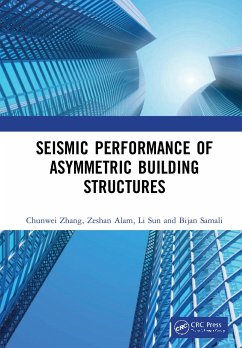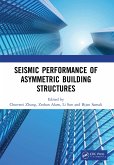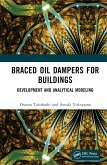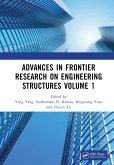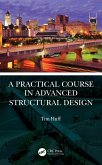Chunwei Zhang, Zeshan Alam, Li Sun, Bijan Samali
Seismic Performance of Asymmetric Building Structures
Chunwei Zhang, Zeshan Alam, Li Sun, Bijan Samali
Seismic Performance of Asymmetric Building Structures
- Gebundenes Buch
- Merkliste
- Auf die Merkliste
- Bewerten Bewerten
- Teilen
- Produkt teilen
- Produkterinnerung
- Produkterinnerung
This work presents comprehensive analytical, computational, experimental investigations, and proposes improved design guidelines that structural engineers can utilize to enhance the seismic design of asymmetric building structures. It will be useful for practicing engineers, experts, and academics, as well as emergency preparedness managers.
Andere Kunden interessierten sich auch für
![Seismic Performance of Asymmetric Building Structures Seismic Performance of Asymmetric Building Structures]() Chunwei ZhangSeismic Performance of Asymmetric Building Structures80,99 €
Chunwei ZhangSeismic Performance of Asymmetric Building Structures80,99 €![Braced Oil Dampers for Buildings Braced Oil Dampers for Buildings]() Osamu TakahashiBraced Oil Dampers for Buildings196,99 €
Osamu TakahashiBraced Oil Dampers for Buildings196,99 €![Advances in Frontier Research on Engineering Structures Volume 1 Advances in Frontier Research on Engineering Structures Volume 1]() Advances in Frontier Research on Engineering Structures Volume 1187,99 €
Advances in Frontier Research on Engineering Structures Volume 1187,99 €![Earthquake Resistant Design of Buildings Earthquake Resistant Design of Buildings]() Muhammad HadiEarthquake Resistant Design of Buildings251,99 €
Muhammad HadiEarthquake Resistant Design of Buildings251,99 €![Seismic Resistant Design and Technology Seismic Resistant Design and Technology]() Dentcho IvanovSeismic Resistant Design and Technology180,99 €
Dentcho IvanovSeismic Resistant Design and Technology180,99 €![Earthquake Engineering and Structural Control Earthquake Engineering and Structural Control]() Srinivasan ChandrasekaranEarthquake Engineering and Structural Control122,99 €
Srinivasan ChandrasekaranEarthquake Engineering and Structural Control122,99 €![A Practical Course in Advanced Structural Design A Practical Course in Advanced Structural Design]() Tim HuffA Practical Course in Advanced Structural Design153,99 €
Tim HuffA Practical Course in Advanced Structural Design153,99 €-
-
-
This work presents comprehensive analytical, computational, experimental investigations, and proposes improved design guidelines that structural engineers can utilize to enhance the seismic design of asymmetric building structures. It will be useful for practicing engineers, experts, and academics, as well as emergency preparedness managers.
Hinweis: Dieser Artikel kann nur an eine deutsche Lieferadresse ausgeliefert werden.
Hinweis: Dieser Artikel kann nur an eine deutsche Lieferadresse ausgeliefert werden.
Produktdetails
- Produktdetails
- Verlag: CRC Press
- Seitenzahl: 232
- Erscheinungstermin: 26. Mai 2020
- Englisch
- Abmessung: 244mm x 170mm x 16mm
- Gewicht: 603g
- ISBN-13: 9780367903435
- ISBN-10: 0367903431
- Artikelnr.: 69936440
- Herstellerkennzeichnung
- Libri GmbH
- Europaallee 1
- 36244 Bad Hersfeld
- gpsr@libri.de
- Verlag: CRC Press
- Seitenzahl: 232
- Erscheinungstermin: 26. Mai 2020
- Englisch
- Abmessung: 244mm x 170mm x 16mm
- Gewicht: 603g
- ISBN-13: 9780367903435
- ISBN-10: 0367903431
- Artikelnr.: 69936440
- Herstellerkennzeichnung
- Libri GmbH
- Europaallee 1
- 36244 Bad Hersfeld
- gpsr@libri.de
Chunwei Zhang obtained his PhD degree from Harbin Institute of Technology in 2005. From 2005 to 2007, he was a research associate in Harbin Institute of Technology; From 2007 to 2010 he was an Assistant Professor at Harbin Institute of Technology. From 2010 to 2015, he was a senior lecturer at Western Sydney University. He is currently a Professor at Qingdao University of Technology and Director of the Structural Vibration Control group. He has also served as the Secretary-general for the Young Researcher's Forum at the 14th World Conference on Earthquake Engineering, and as committee member of the Dynamics and Control Division of American Society of Civil Engineer (ASCE). He has been in charge of and has participated in several major research programs, including general projects from National Science Foundation of China (NSFC), Key Technology R&D and 863 discovery and 973 major fundamental programs from Ministry of Science and Technology of China as well as industry grants etc. He was also the external assessor for National Science Foundation of China. His research interests include structural control, blast resistance and protective engineering. He has been awarded the first grade prize for Science and Technology Progress in 2009 by China Ministry of Education, and the Japan Society of Seismic Isolation (JSSI) award in 2004, and the best paper award for the eleventh international symposium on Structural Engineering. Zeshan Alam obtained his Bachelor's Degree in 2010 from the University of Engineering and Technology, Peshawar, Pakistan and his Master's degree in Structural Engineering in 2012 from the National University of Sciences and Technology, Pakistan. He is currently a PhD candidate at the Centre for Infrastructure Engineering at Western Sydney University, Australia and a visiting research fellow at Qingdao University of Technology, China. His research interests are Earthquake Engineering and Structural Dynamics, Structural health monitoring and Performance assessment of asymmetric structures. Li Sun obtained her PhD degree in 2006 from Dalian University of Technology. She is currently a Professor at the School of Civil Engineering, Shenyang Jianzhu University, China. Her research interests are structural health monitoring, damage identification and applications of intelligent materials in civil engineering. Bijan Samali obtained his PhD degree in 1984 from George Washington University, USA. He is currently the Director of Centre for Infrastructure Engineering at Western Sydney University, Australia. Prior to joining Western Sydney University, Professor Samali held a Personal Chair in Structural Engineering at UTS since 1999. He is the author or co-author of over 500 scholarly publications (including over 150 journal publications), on a wide range of topics in the areas of structural engineering, structural dynamics, vibration and motion control, wind and earthquake engineering, bridge engineering, damage detection and health monitoring of structures including keynote addresses and invited papers. More recently, he has also focused on concrete technology and pavement engineering with particular emphasis on developing new, green and sustainable concrete and pavements with superior properties including geopolymer and self-compacting concrete. He has also been involved with several major projects as a specialist consultant over the years.
1 Introduction to the Seismic Performance of Asymmetric Building Stuctures
2 A Review of Research on Design Guidelines and Seismic Performance of Asymmetric Building Structures
3 Experimental Strategy and Seismic Loading Program
4 Damage Response Investigation of Asymmetric Building Structures
5 Numerical Evaluation of Complex Local Behavior
6 Global Seismic Behaviour of Asymmetric Building Structures
7 Influence of Design Parameters on the Statistical Distribution of Structural Response
8 Seismic Design Guidelines for Asymmetric Building Structures
9 Conclusions
Appendices.
2 A Review of Research on Design Guidelines and Seismic Performance of Asymmetric Building Structures
3 Experimental Strategy and Seismic Loading Program
4 Damage Response Investigation of Asymmetric Building Structures
5 Numerical Evaluation of Complex Local Behavior
6 Global Seismic Behaviour of Asymmetric Building Structures
7 Influence of Design Parameters on the Statistical Distribution of Structural Response
8 Seismic Design Guidelines for Asymmetric Building Structures
9 Conclusions
Appendices.
1 Introduction to the Seismic Performance of Asymmetric Building Stuctures
2 A Review of Research on Design Guidelines and Seismic Performance of Asymmetric Building Structures
3 Experimental Strategy and Seismic Loading Program
4 Damage Response Investigation of Asymmetric Building Structures
5 Numerical Evaluation of Complex Local Behavior
6 Global Seismic Behaviour of Asymmetric Building Structures
7 Influence of Design Parameters on the Statistical Distribution of Structural Response
8 Seismic Design Guidelines for Asymmetric Building Structures
9 Conclusions
Appendices.
2 A Review of Research on Design Guidelines and Seismic Performance of Asymmetric Building Structures
3 Experimental Strategy and Seismic Loading Program
4 Damage Response Investigation of Asymmetric Building Structures
5 Numerical Evaluation of Complex Local Behavior
6 Global Seismic Behaviour of Asymmetric Building Structures
7 Influence of Design Parameters on the Statistical Distribution of Structural Response
8 Seismic Design Guidelines for Asymmetric Building Structures
9 Conclusions
Appendices.

